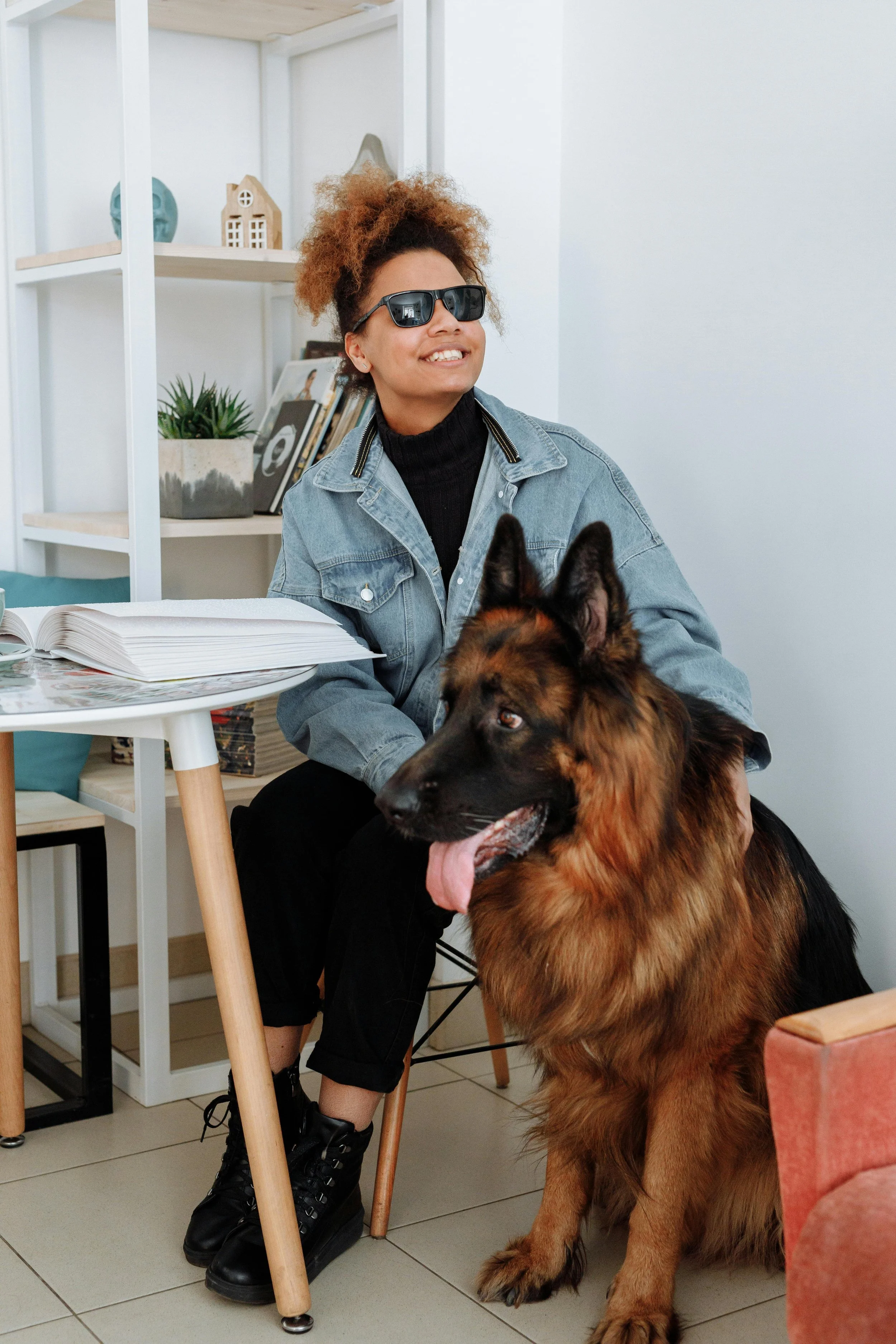Building a Relationship With Your Service Dog
Affiliate Disclosure
Some of the links on this blog are affiliate links. This means that if you click on a link and make a purchase, I may earn a commission at no additional cost to you. I only recommend products and services I genuinely believe in. Thank you for your support!
Just like human coworkers or teammates, dogs and handlers need to learn each other's rhythms and needs. Bonding time is essential to ensure that the dog recognizes their handler as the person to focus on in any environment.
This period often requires spending most of each day with the dog. Handlers must be available for:
Frequent training sessions
Supervised exposure to new environments
Reinforcing obedience and task performance
Socialization and Exposure
Even well-trained dogs must adapt to their new handler’s lifestyle and community. This means visiting parks, public transportation, stores, offices, and medical settings to help the dog acclimate. Each outing is not just a routine trip—it’s also a learning opportunity that requires time and patience.
Daily Responsibilities
Caring for a service dog is a daily responsibility that goes far beyond feeding and walking.
Feeding and Bathroom Routines
Service dogs must eat a balanced diet at consistent times. Bathroom breaks also follow a predictable schedule, often requiring outings multiple times a day. For handlers who live in urban areas or don’t have access to a yard, this becomes even more time-consuming.
Grooming and Hygiene
Depending on the breed, service dogs may need brushing several times a week or daily. Routine maintenance includes:
Nail trimming
Ear cleaning
Bathing
Checking for ticks or skin conditions
Neglecting grooming not only affects the dog’s health but also their ability to work in public settings.
Exercise and Play
Service dogs need physical exercise and play to maintain health and motivation. This might mean two walks a day, active games like fetch, or structured agility work. Lack of activity can lead to behavioral problems or physical decline.
Mental Stimulation and Task Practice
Service dogs perform highly specialized tasks—like alerting to medical conditions, guiding around obstacles, or fetching medications. These tasks require regular practice to keep sharp. Handlers must schedule daily or weekly sessions to reinforce these behaviors.
Ongoing Training and Maintenance
Training doesn't end after the initial placement or graduation from a program. Service dogs need ongoing reinforcement throughout their working lives.
Public Access Training Refreshers
Dogs must consistently behave in public—no barking, sniffing, begging, or being distracted. This level of discipline requires frequent outings and intentional training in various settings.
Refinement and Adjustment
As the handler's needs change, so too must the dog’s behavior. New medical symptoms may require new tasks. Changes in environment (like moving cities or jobs) can also demand retraining or adjustment time.
Working with Trainers
Many handlers regularly consult with professional trainers for refreshers or problem-solving. This may mean:
Weekly in-person sessions
Virtual coaching
Attending training workshops
Medical Care and Preventative Health
Caring for a service dog’s physical well-being is vital to their effectiveness and longevity.
Veterinary Care
Routine appointments for vaccinations, parasite control, and dental cleanings take time to schedule and attend. Unexpected illnesses or injuries can require days or even weeks of focused care.
Health Monitoring
Handlers must be attentive to subtle changes in behavior or energy level that may signal health problems. Monitoring weight, appetite, and behavior is a daily task.
Time Considerations for Handlers with Disabilities
Many service dog handlers face additional challenges that can make time management even more difficult.
Physical disabilities may slow down grooming, training, or walking routines.
Cognitive impairments or fatigue may impact consistency.
Mental health conditions can complicate routines and make daily tasks feel overwhelming.
Caregivers or family members may need to step in for support, but the responsibility ultimately remains with the handler.
Managing Public Interactions
Service dogs attract attention. Handlers must frequently deal with interruptions, questions, and even confrontations.
Educating the Public
It’s common for people to:
Try to pet the dog
Ask invasive questions about the handler’s disability
Challenge the legitimacy of the dog
This requires time, patience, and often emotional energy to manage.
Planning Outings
What would be a quick errand for someone else can turn into a multi-hour endeavor for a service dog team. Planning dog-friendly transportation, ensuring access rights, and carrying documentation all add to the time investment.
Emotional and Mental Investment
Service dog ownership isn’t just physical—it’s emotional.
Emotional Labor
Handlers often feel a strong sense of duty to care for their dogs, which can create anxiety when routines are disrupted or the dog gets sick.
Guilt and Perfectionism
It’s common to feel guilty if the dog is under-exercised, if training lags, or if they behave inappropriately in public. These feelings can add to stress, especially when the dog’s performance is essential to the handler’s independence.
Long-Term Commitment Over the Dog’s Lifespan
Service dogs usually work for 8 to 10 years. After that, they retire but still require care.
Retirement Planning
Handlers must:
Transition to a new working dog
Continue to care for the retired dog (now as a pet)
Balance the needs of both dogs if overlap occurs
Training a successor dog takes time and effort—often while still caring for the previous one.
Lifespan and End-of-Life Care
Eventually, every dog ages and faces health issues. This phase often involves increased veterinary visits, medications, and caregiving—requiring even more time.
Conclusion
Owning a service dog is a 24/7 responsibility. From the first day of bonding to the last days of retirement, handlers must dedicate time each day to training, care, and companionship. The relationship is deeply rewarding but also demanding, and it requires thoughtful planning and flexibility.
Prospective service dog handlers should understand that this is not a part-time role—it is a full-time partnership. With preparation, support, and a strong commitment, service dog ownership can provide life-enhancing independence and emotional connection that is well worth the investment.
